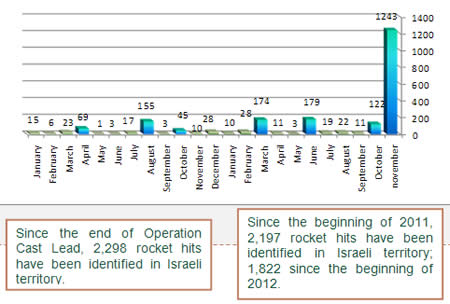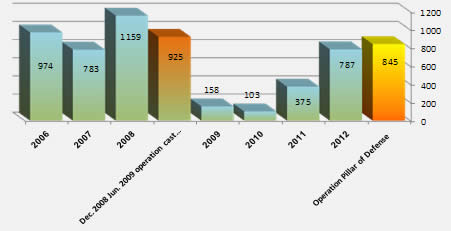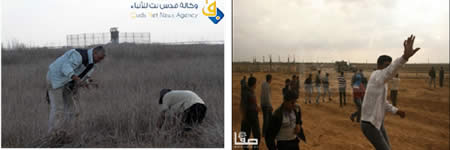- So far, Hamas and the other terrorist organizations operating in the Gaza Strip have complied with the understandings achieved to end Operation Pillar of Defense. Since 2300 hours, November 21, no rockets or mortar shells have been fired into Israeli territory. On November 23 Palestinians rioted near the security fence. Hamas' security forces deployed along the border fence to enforce the ceasefire.
- Mahmoud Abbas and senior members of the Palestinian Authority are determined to raise before the UN General Assembly the issue of upgrading the PA's status, having chosen the symbolic date of November 29.[1] Hamas, which formerly opposed the step, now supports it.
Fulfilling the Ceasefire Understandings
- Eight days after it began, Operation Pillar of Defense ended when understandings were reached regarding a cessation of hostilities as of 2100 hours, November 21, 2012. Until 2300 hours sporadic rocket fire continued into Israeli territory (an estimated ten hits). As of November 27, since 2300 hours, November 21, the ceasefire has been maintained almost in toto.
IDF Strikes – Data from the IDF Spokesman
- According to the IDF Spokesman, the IDF achieved its objectives and struck a severe blow to Hamas and its military-terrorist capabilities. Its infrastructure was seriously damaged by the IDF, including its chain of command and control; its terrorist capabilities, facilities, bases and senior commanders. Its strategic capabilities were struck by the IDF, among them its long-range rockets (capable of hitting targets at a distance of 40 kilometers, or 25 miles) and hundreds of rocket launchers and medium- and short-range rockets. Thusthe IDF significantly disrupted Hamas' rocket-launching capabilities. In addition, the Iron Dome aerial defense system was highly successful, and only 7% of the rockets launched into Israeli territory fell in populated areas. Israel's military achievements led to the conditions for the ceasefire understandings (IDF Spokesman, November 22, 2012).
- A total of 1,500 terrorist targets throughout the Gaza Strip were attackedin Operation Pillar of Defense (IDF Spokesman, November 22, 2012).
· 30 senior Hamas and Palestinian Islamic Jihad operatives
· 19 command centers
· 980 underground rocket launchers
· 140 tunnels used to smuggle weapons
· 66 tunnels used for terrorist activities
· 42 Hamas situation rooms and bases
· 26 weapons workshops
· Dozens of long-range rocket launchers and launching sites
Israel
In Israel's south during Operation Pillar of Defense there were 1,790 instances of property damage resulting directly from rocket and mortar shell fire. Places of business, private buildings and homes, vehicles and agricultural equipment were damaged. An estimated 30 families whose homes were hit were moved to hotels. The damage to commerce and industry was estimated at 200 million shekels (about $52 million). Of the approximately 500 factories in southern Israel, only five took direct rocket hits (Haaretz' TheMarkersupplement, November 23, 2012).
The Gaza Strip
Taher al-Nunu, spokesman for the de-facto Hamas administration, told a press conference that according to an initial assessment, 800 buildings in the Gaza Strip were damaged, 200 of which were completely leveled. In addition 42 Hamas governmental and security institutions and structures were destroyed. The total amount of damage was allegedly estimated at $1,245,000,000, of which $554 million was direct damage and $700 million was collateral damage (Hamas' Al-Aqsa TV, November 25, 2012).
- During Operation Pillar of Defense more than 1,400 rockets were fired from the Gaza Strip; 854 rocket hits were identified in Israeli territory (See graphs).
Rocket Hits in Israeli Territory since the Beginning of 2011[1]

Annual Distribution of Rocket Fire[2]

*As of November 27, 2012.
Deployment of Hamas Security Operatives along the Security Fence
- Islam Shahawan, spokesman for the ministry of the interior of the de-facto Hamas administration, reported that on November 25 operatives of the Hamas security forces had been deployed along the border fence between Israel and the Gaza Strip to enforce the ceasefire. In our assessment, they were deployed to enforce order after Palestinians rioted near the fence (See below).
Riots near the Security Fence
- When the ceasefire was declared Palestinians initiated gatherings near the security fence along the Gaza Strip border in a show of presence and to defy Israel. On November 23 an estimated 300 Palestinians approached the fence at a number of locations in the southern Gaza Strip and began rioting and damaging the fence. IDF forces tried to distance the rioters from the fence and when they refused to leave warning shots were fired. The rioters continued their attempts to damage the fence and enter Israeli territory, and shots were fired (Ynet, November 23, 2012). The Palestinian media reported one Palestinian killed and more than ten wounded (Ma'an News Agency, November 23, 2012).
- On November 26 the Palestinian media reported two Palestinians wounded by IDF fire near Kerem Shalom (southern Gaza Strip) (The PIJ's PalToday and the Alresala.net websites, November 26, 2012). In addition, Palestinian farmers began working the land near the security fence (Safa News Agency and Qudsnet websites, November 27, 2012).

Left: Palestinians approach the security fence in the southern Gaza Strip (Safa News Agency, November 23, 2012). Right: Palestinian farmers work the land east of Khan Yunis near an IDF post (Qudsnet website, November 27, 2012).
Palestinian Terrorist Infiltrates an Israeli Village near the Gaza Strip
- On the night of November 25, a Palestinian who infiltrated into Israeli territory from the Gaza Strip through the security fence entered the village of Sdei Avraham in the northwest Negev, about 4 kilometers, or 2.5 miles from the Gaza Strip. He entered a house and threatened a woman, one of its residents, who was awake at the time, with a knife and metal rod. She struggled with and finally overcame him and managed to call for help; she was cut and bruised during the struggle. IDF forces arriving on the scene chased the terrorist, who refused to halt, and shot and killed him. The IDF and Israel's security services are investigating the event. According to initial assessments, the Palestinian attacker did not belong to any Palestinian terrorist organization (Ynet and Israel Channel 10 TV, date, 2012).
Hamas Delegation Leaves for Cairo to Discuss the Details of the Pillar of Defense Understanding
- The Palestinian media reported that on November 25 a delegation representing the de-facto Hamas administration led by deputy Hamas head Ziad al-Zaza arrived in Cairo for Egyptian-mediated indirect talks with Israel for implementing the ceasefire. Among items on the agenda were the crossings, borders, and imports and exports (Safa News Agency, November 26, 2012).
- The ceasefire was met with spontaneous mass demonstrations of joy in the Gaza Strip, including shots fired into the air, fireworks, parades and the distribution of cake and candy. Hamas and the other terrorist organizations held parades throughout the Gaza Strip to show happiness, attended by senior figures. Mahmoud al-Zahar marched in one of the parades dressed in a combat uniform and holding a sawed-off M-16 assault rifle with a telescopic sight (Hamas-affiliated Filastin al-'Aan, November 25, 2012).
Return to Routine and Beginning Rebuilding
- The Gaza Strip has started to return to routine life. Gazans who left their homes are beginning to return, especially in the southern Gaza Strip, and the markets have reopened, as have schools and universities. The de-facto Hamas administration is trying to show that it continues to govern and that its governmental sites (some of which were damaged during Operation Pillar of Defense) are functioning as usual.
- On November 25 Hamas' Islamic National Bank, which was attacked by the IDF, reopened the doors of its Gaza City and Khan Yunis branches. Muhammad Ghanem, head of finance and investment, claimed that the bank's functioning had not been affected and that most of the damage and losses were property-related (Safa News Agency, November 25, 2012).
- Pictures uploaded to the Internet show that the markets are open and that there is no lack of food, and that pedestrians and vehicles fill the streets of Gaza City (Hamas-affiliated Filastin al-'Aan, November 26, 2012).
Shipments of Humanitarian Assistance and Delegations to the Gaza Strip
- After Operation Pillar of Defense shipments of humanitarian assistance and delegations of solidarity activists continued to arrive in the Gaza Strip. On November 24, 30 trucks carrying 100 tons of food and medical supplies arrived through the Rafah crossing. They were sent by a Turkish organization called "Cansuyu." A 16-member delegation arrived with the shipment, entering through the Rafah crossing. (Shihab, November 25, 2012). On November 26 an 85-member delegation arrived from Iraq, 50 of them members of parliament. They brought a $1.6 million donation for hospitals in the Gaza Strip (Safa News Agency, November 26, 2012).
Hamas
- Hamas represents the most recent escalation as an achievement and victory, and continues the battle for hearts and minds by establishing a "victory narrative." Senior Hamas figures publicly expressed their satisfaction with the ceasefire and claimed they were committed to honoring it. They also praised the part played by Egypt and its president, Mohamed Morsi, in brokering it.
- According to a statement issued by Hama's military-terrorist wing, the Izz al-Din al-Qassam Brigades, 1,573 rockets were fired, hitting Israeli planes, ships, military vehicles, etc. It also claimed that long-range rockets, some of them manufactured in the Gaza Strip, had been fired for the first time, reaching targets 80 kilometers (50 miles) away and forcing Israel "to raise a white flag." The Palestinian Islamic Jihad announced it had fired 620 rockets and mortar shells. In our assessment, the numbers of both Hamas and the PIJ were exaggerated.
- The following are statements made by senior Hamas figures about the agreement to end the fighting:
· Interviewed by Al-Jazeera TV, Khaled Mashal said that Hamas would honor its commitments to the agreement, but that if Israel violated the agreement Hamas would return to firing rockets (Al-Jazeera TV, November 26, 2012).
· Ismail Haniya, head of the de-facto Hamas administration, said that his administration was pleased with the agreement and committed to it. He added that he was proud of the firm stance of the Gazans during the fighting (Qudsnet website, date, 2012).
· Musa Abu Marzuq, deputy chairman of Hamas' Executive Committee, said that the agreement was an achievement for the Palestinian people and for Palestinian unity because it had halted Israel's aggression and dealt with stalled issues (Egyptian national TV, November 21, 2012).
· Izzat al-Rishq, a member of Hamas' Executive Committee, said that the agreement was an honorable victory for the entire "resistance" [i.e., terrorist organizations]. He said Israel had decided on a unilateral ceasefire first in order not to show it had capitulated to the conditions of the Palestinian "resistance" (Al-Quds TV, November 21, 2012).
The Palestinian Islamic Jihad
- The PIJ's military-terrorist wing held a press conference to stress the "victory." A spokesman for the wing, who appeared with his face masked, said that the latest round of fighting proved that Tel Aviv was no longer a target "which cannot be conquered" but rather "a game piece in the hands of the fighters of jihad and the resistance" (The PIJ's PalToday website, November 22, 2012).
The Palestinian Authority
- Mahmoud Abbas, PA chairman, expressed support for the ceasefire, saying that the situation necessitated continued efforts for its preservation and to prevent Israel from "offensive actions" and to bring about the end of the "siege" on the Gaza Strip. He said that every effort by Israel to isolate the Gaza Strip from Judea and Samaria had to be prevented. He added that Egypt was not to be given responsibilities which would harm its national security or the national Palestinian interests (Wafa News Agency, November 21, 2012).
Sources in Gaza: Ehud Barak Resigned over the Failure of Operation Pillar of Defense
- Spokesmen for the terrorist organizations in the Gaza Strip rushed to claim that Ehud Barak, the Israeli minister of defense, had resigned because of the "failure" of Operation Pillar of Defense:
· Hamas' department of propagandasaid in a statement that Ehud Barak's resignation was "proof" of the victory of the "resistance" [i.e., the terrorist organizations] which had "destroyed" his career. According to the statement, even though he had left political life, he could not avoid responsibility for the "crimes" he committed and that the Palestinians would continue their efforts to bring him and others to trial (Al-Ra'i website, November 26, 2012).
· Abu Ahmed, spokesman for the PIJ's military-terrorist wing, said that Ehud Barak's resignation was a direct response to the "defeat" he and his army had suffered in the Gaza Strip. He also said that in his opinion, as a result the Israeli prime minister might also resign (The PIJ's PalToday website, November 26, 2012).
Statements Regarding Iranian Military Support to the Gaza Strip
- Senior Hamas figures continueto note Iran's involvement and support for the Gaza Strip. At the same time, they were careful to stress that Hamas made its decisions independently and was not dependent on Iran:
· Mahmoud al-Zahar, a member of Hamas' Executive Committee, said that he did not want to deny that Iran had given Hamas arms and money. He said that the money had been invested in developing the rockets which had longer ranges than the rockets given to them by Iran. He claimed Iran had never demanded anything of Hamas and that was why Hamas was willing to accept its support (Al-Aqsa TV, November 22, 2012).
· On another occasion Mahmoud al-Zahar, speaking to operatives from Hamas' military-terrorist wing, said that some of the rockets had been manufactured in Iran. He said Iran supported Hamas with money and arms. He reiterated the claim that Iran had not asked for anything in return but only that the rockets be used "to liberate Palestine" (Al-Sharq Al-Awsat, London, November 24, 2012).
- The PIJ's military-terrorist wing held a press conference where a spokesman for the organization thanked all those who supported the "resistance" [i.e., terrorist organizations]with money and weapons. They had used them, he said, to change the equation [between them and Israel], and he especially thanked the "brothers" in Iran and Egypt. He saidIran, with its support, had fulfilled its duty (The PIJ's PalToday website, November 22, 2012).
Detention of the Perpetrators of the Terrorist Attack in Tel Aviv
- On November 21 a joint action of the security forces led to the detention of the perpetrators of the terrorist attack on the bus in Tel Aviv on the last day of Operation Pillar of Defense (November 21). They were members of a network affiliated with Hamas and the PIJ, most of them from the village of Beit Leqia, southwest of Ramallah.
- According to the initial interrogation, they placed the bomb on the bus and used a cell phone to detonate it. They enlisted an Israeli Arab from the village of Tayibe who originally came from Beit Leqia to bring the bomb to Tel Aviv. They used the car of his Arab employer, a resident of east Jerusalem, without his knowledge. The Israeli Arab placed the bomb on the bus and informed his handler in Beit Leqia, who then then used a cell phone to detonate it (IDF Spokesman, November 22, 2012). Twenty-seven civilians were hurt in the blast.
[1] As of November 27, 2012. The statistics do not include mortar shell fire.
[2] The statistics for 2008 and 2009 include rocket hits identified during Operation Cast Lead. They do not include mortar shell fire.













